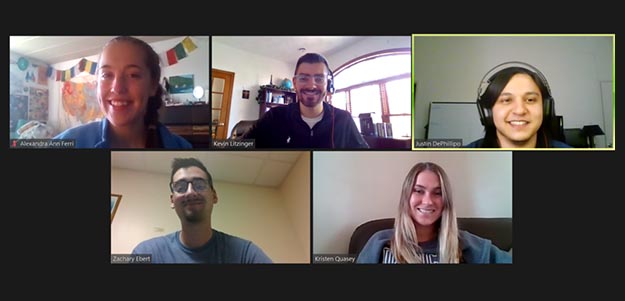
The team of engineering students, who only met virtually during their semester-long project, successfully delivered a testing device to be used in COVID-19 related research. IMAGE: PROVIDED BY KEVIN LITZINGER
Engineering students draw inspiration from art to test COVID-19 biodevice
Senior capstone team partners with professor of sculpture to test Penn State Center for Biodevices-designed respiratory safeguards for endoscopic surgeons
1/6/2021
By Erin Cassidy Hendrick
UNIVERSITY PARK, Pa. — As a discipline, engineering often challenges students to fuse technical skills with creative design. During the fall semester, a Penn State College of Engineering senior capstone design group took this notion one step further through a collaboration with Bonnie Collura, professor of art and sculpture in the Penn State School of Visual Arts.
The students explained that, with Collura’s guidance, their final project was able to successfully assist their sponsor, the Penn State Center for Biodevices, in its COVID-19-focused research.
According to Mary Frecker, professor of mechanical engineering and biomedical engineering and the director of the Center for Biodevices, surgeons are in need of extra protection when performing endoscopic skull surgery. When surgeons are performing these operations to treat brain tumors and other conditions, aerosols are generated in the patient’s nose, which presents new challenges for surgeons during the pandemic.
“During these surgeries, clinicians may be exposed to aerosol droplets from the mouth and nose of patients that have COVID-19 or other infectious respiratory conditions,” Frecker said. “Since patients aren’t able to wear face masks during surgery, we are exploring the design of protective nasal coverings with unique geometries to seal a patient’s nose.”
As part of the University’s response to the COVID-19 pandemic, researchers constructed a chamber where masks and various filtration materials could be tested for efficiency. However, for the nasal coverings, the team needed a specially shaped mannequin-like structure, mimicking a person’s face.
That’s where the senior capstone group, comprised of undergraduate engineering students Kristen Quasey, Kevin Litzinger, Alexandra Ferri, Zachary Ebert and Justin DePhillipo, came in. Their task was to design and fabricate the “face” of the testing chamber, allowing researchers to optimize and test their coverings.
“When we first started talking about this project, we thought back to our art classes in high school, where you’d recreate a person’s face with something like papier-mâché,” Quasey said.
The influence of art did not end there.
In their rapid prototyping phase, the team ran into challenges while finding the right material. They consulted with Zoubeida Ounaies, professor of mechanical engineering and the course instructor, who connected the students with Collura.
With a wealth of experience as a sculptor, Collura was happy to help.
“At first, I was asked if I had recommendations for what kind of molding material they could use,” she said. “That’s a big question even for artists to answer.”
The team eventually settled on a 3D-printed “nose” and a larger “face” traditionally casted in silicone, which they determined could reasonably recreate the texture of a person’s skin and fit other needed parameters.
By December, the team delivered testing fixtures that are now being used by the Center for Biodevices.
Intrigued by the project and the students’ enthusiasm, Collura became an unofficial but trusted adviser for the team throughout the semester. While the end result was a biomedical testing product, the students described her materials expertise and perspective as an artist as transformational.
“I see a lot of similarities between art and engineering. You can be really creative, which isn’t talked about as much in engineering,” Litzinger said. “People only think about dealing with math and physics.”
Collura echoed that sentiment and said, “What sculpture does is make the invisible visible. It asks questions. You start by breaking down the subject matter, respond to your materials and make revisions all along the way. I saw the same in this engineering prototype process.”
While this collaboration was not planned, the students said they believe it enhanced the final product and enriched their perspectives as engineers.
“I’d love to see more silos broken down between disciplines like we’ve done in this project,” Ferri said. “As engineers, we want to make the best and most user-friendly products, and that can often mean getting advice from unlikely sources.”
Matt Parkinson, professor of engineering design and director of the Bernard M. Gordon Learning Factory, facilitated the funds needed to support this team's project.



